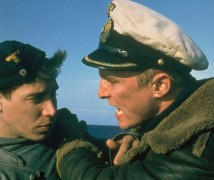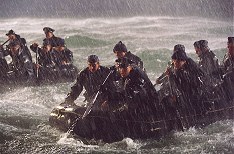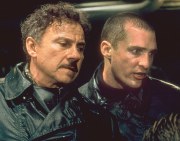|
U-571
|
| |
 |
USA,
2000. Rated PG-13. 116 minutes.
Cast: Matthew McConaughey, Harvey
Keitel, Bill Paxton, Jon Bon Jovi, Jake Weber, David Keith, Terrence Carson,
Jack Noseworthy, Tom Guiry, Thomas Kretschmann, Matthew Settle, Erik Palladino
Writers: Jonathan Mostow (story & screenplay), Sam Montgomery (screenplay),
David Ayer (story)
Music: Richard Marvin
Cinematographer: Oliver Wood
Producers: Dino De Laurentiis, Martha De Laurentiis
Director: Jonathan Mostow
|
| Grade: B |
Review by
Carlo Cavagna |
 laustrophobia.
For most of us, the idea of being trapped, powerless, in a confined space is
one of our most basic fears. Make that confined space a tiny, life-sustaining
compartment that may burst at any second, with only a few inches of steel between
you and billions of megatons of frigid water, and you've got a sure-fire recipe
for terror. Perhaps that's why film after film has returned to the depths of
the ocean. Claustrophobia works. It's the essence of any thriller or horror
movie set underwater, whether it's The Poseidon Adventure, Deep
Blue Sea, or The Abyss. So it is with U-571.
laustrophobia.
For most of us, the idea of being trapped, powerless, in a confined space is
one of our most basic fears. Make that confined space a tiny, life-sustaining
compartment that may burst at any second, with only a few inches of steel between
you and billions of megatons of frigid water, and you've got a sure-fire recipe
for terror. Perhaps that's why film after film has returned to the depths of
the ocean. Claustrophobia works. It's the essence of any thriller or horror
movie set underwater, whether it's The Poseidon Adventure, Deep
Blue Sea, or The Abyss. So it is with U-571.
Two other recent submarine movies, The Hunt for Red October and Crimson
Tide, forgot this principle. October (rating: B) worked
best aboard Sean Connery's defecting Russian vessel as it dodged both U.S. and
Russian obstacles alike, but it frequently interrupted that suspenseful atmosphere
to develop author Tom Clancy's gordian geopolitical framework. Similarly, Tide
(rating: C+) was overwhelmed by its star power–the Hackman vs. Washington
conflict over whether to launch the sub's nuclear missiles was the main focus
of the film. 
U-571 succeeds because it returns to the basics. The special effects
serve the story, not the other way around. The subplots, few in number, fold
neatly into the main narrative and flesh out the characters enough to make you
care about them. The World War Two narrative is developed only to the extent
necessary to maneuver the heroes into a leaky boat, dodging torpedoes and depth
charges 150 feet underwater. Anything more is dispensed with.
In fact, U-571 doesn't even wait to establish its plot and protagonists.
It opens with a lengthy prologue that not only establishes the premise but also
the oppressive atmosphere that characterizes the entire movie. A German submarine,
after torpedoing a British vessel, finds itself under heavy attack. Its position
is so vulnerable that we even begin to sympathize with the crew (at least until
they carry out some of Hitler's more brutal orders), because being trapped underwater
is just plain wrong.
The German sub is disabled, but manages to surface after the British leave
the area. Dead in the water, it must wait for a repair team to sail out from
France. In the meantime, the Americans have intercepted the sub's coded message
and assume, correctly, that it is a call for help. Enter Lieutenant Commander
Dahlgren (Bill Paxton), Lieutenant Tyler (Matthew McConaughey), Chief Klough
(Harvey Keitel), and their crew. Their submarine is painted with Nazi markings
and ordered to pose as a German repair crew. The goal is to capture the German
submarine and the Enigma Machine on board, an encryption device that would allow
the Allies to decode the Germans' military communications. 
If you've seen the preview, you know what happens. The Americans, who include
Emmett (an unrecognizable Jon Bon Jovi), Wentz (Jack Noseworthy), and intelligence
officers Coonan (David Keith) and Hirsch (Jake Weber), wind up on the German
submarine with Tyler in command and are caught in a desperate struggle to survive.
Along the way, good-guy Emmett, who has been denied his own command because
of concerns about his ability to make tough decisions, will have to win the
trust of the crew and find the courage to choose who lives and who dies.
U-571 contains no surprises, nor does it break new cinematic ground.
Every outcome can easily be guessed in advance. U-571 is not a film you'll
need to see more than once. But U-571 works. It's designed as a rapid
series of nail-biting climaxes, moving smoothly from one to the next, not giving
you time to think about its predictability, and never giving you relief from
the oppressive claustrophobia. The fine actors, well-known enough to draw audiences
but not well-known enough to be distracting (it helps that they have anonymous
crew cuts), are careful never to break the mood, so that the anxiety of the
characters and of the audience become one.
U-571 is exactly what it is advertised to be: a relentlessly taut, edge-of-your-seat
action thriller. It's as good as a by-the-numbers "summer movie" can be. That
itself is a notable achievement. Numerous big-budget and star-laden thrillers
are released each year, each trying to one-up the previous year's films while
sticking to the tried-and-true formula. A growing number of these movies fall
on their faces (remember Volcano? Batman and Robin? Godzilla?)
because they have nothing to offer other than the fact that they're bigger and
louder. U-571 reverses course, remembering that true thrills are generated by
giving us characters we can care about and playing viscerally on our most irrational
fears.
Note: U-571 has been criticized for being historically inaccurate,
and it is. The entire episode depicted is fictional. The British captured the
Enigma Machine, not the Americans. So what? Are we now depending on summer movies
for our history lessons?
Review
© May 2000 by AboutFilm.Com and the author.
Images © 2000
Universal Studios.



